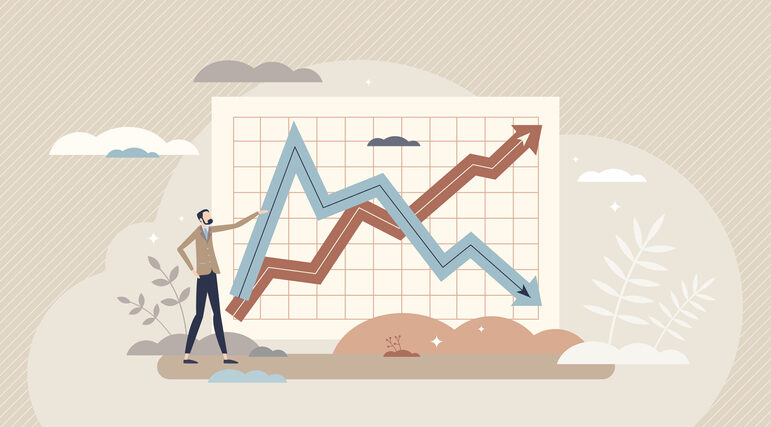This is the first piece within the private market series that will explore the evolution happening within alternatives and the private market investment landscape. Over

The “S” Word
April 26, 2023
Even though George Carlin and others have long pushed the boundaries, there are still some words—including a certain “S” word—that are typically not used in polite company. In the investment arena, there is another unwelcome “S” word that most people prefer not to speak of. That word is stagflation. And yet, there are increasing whispers and worries these days about whether this condition might happen again after many decades of it not being a problem at all. So, what does stagflation mean and is it something to really be concerned about?
Stagflation is characterized by slow economic growth and rising, or persistently high, prices. These two problems rarely coincide, as slowing economic growth usually curbs demand, putting downward pressure on prices. Conversely, rising prices are generally driven by demand that exceeds supply, a byproduct of an economy that is rapidly growing. However, as we saw in the 1970s, stagflation can happen.
Economists generally agree that the two conditions that cause stagflation are a supply shock, such as a rapid increase in the price of oil, and/or government policies that hurt industries at the same time economic stimulus is contributing to the money supply growing. During the 1970s, both factors were present and, importantly, the U.S. had also just moved away from the gold standard which caused a significant decline in the U.S. dollar. Stagflation is particularly tricky because it puts policymakers in a tough position since lowering interest rates to support the economy can make an inflation problem worse. While there are some similarities between the 1970s and today, there are many important differences that, in our view, make stagflation an improbable outcome.
The pandemic environment was characterized by some of the most unique supply shocks in history. They included a shock to the labor force as fewer people were working, a shock to services as many service providers were not able to operate in the locked-down environment, a shock driven by $5 trillion dollars of stimulus money flowing into the U.S. economy, and the resulting shock this stimulus triggered in demand for goods. All of these factors contributed to rising prices; and as if this wasn’t enough, it was soon followed by the Russia-Ukraine War which resulted in an additional supply shock to food and natural gas.
Even though living through the shocks of the past few years was unpleasant, generous government stimulus supported the economy and prevented an economic slowdown. The nature of these recent shocks was also quite different than in the 1970s. During the ’70s, an oil embargo imposed on the U.S. by OPEC nations caused the price of oil to quadruple in a very short period of time. This was in an era when oil was much more important to the U.S. economy. In fact, the amount of oil used per dollar of GDP was at its peak at one barrel of oil per $1,000 of GDP in today’s dollars, and this figure has since declined by more than 55% as humanity has become much more efficient in the use of oil.1
Even though these two eras experienced very different types of shocks, we were nonetheless facing inflation of over 9% less than a year ago. Thankfully, though, we have seen clear evidence that many of the price increases we experienced early in the pandemic—goods, housing, and autos—have begun to normalize and decline. Importantly, the way that some of these prices are measured results in a long lag time between what we see happening today and when the prices get reflected in the measurements. The biggest example of this is the shelter category in the Consumer Price Index (CPI). Shelter now makes up more than 40% of overall CPI and we have yet to see a meaningful change in prices in this category. Still, we know that home prices have declined from their highs and several other measures of rent are suggesting that prices are coming down in response to a large supply of newly built multi-family housing units coming on the market. In our view, these prices should begin to filter through in a few months’ time and, given the size of the shelter category, they will have a significant impact on the overall inflation figure.
While the goods sector was responsible for most of the inflation we experienced during the pandemic years, the services sector is now also contributing to inflation. Over the last two years, wages have grown between 5-6% following a decade where wage growth rarely topped 3%. Even though this is significant, real wage growth has actually been negative as wages have not kept pace with the overall rate of inflation. While the overall job market remains healthy, we are seeing signs of some softening as the number of open jobs has declined from its peak and some industries have announced layoffs.
This trend demonstrates another important evolution that has taken place over the last fifty years. The U.S. economy has become more flexible as labor union membership has declined. When union membership is high, it has generally meant that wage increases have been unavoidable and that companies have had less flexibility to reduce staff during economic slowdowns. According to the Bureau of Labor Statistics, the unionization rate of private workers was 6% in 2022, the lowest level recorded in history. This compares to the 1970s when it was more than 20%. This shift away from unions happened in response to rising global competition and outsourcing. While there is a move to bring manufacturing back to the U.S., which could result in more union formation, this will take many years to develop and would surely span more than one economic cycle. In the shorter term, companies will have the flexibility to adjust labor in response to economic trends.
But what about government policy? Even though the Federal Reserve began raising interest rates later than many felt they should, their actions have been aggressive over the last year, and this is quite different from the accommodative stance during the early part of the 1970s. Initially, we saw very little impact from this action, but following the recent failure of two sizable banks, we are now seeing financial conditions begin to tighten. The tightening of financial conditions generally means that loans are harder to get, and this leads to economic slowing. This slowing should contribute to inflation coming down if the employment market softens, rents decline, and demand for goods and services eases. If the economy slows enough, the Federal Reserve will eventually lower interest rates. Indeed, this is an outcome that the bond market is predicting will happen by the end of this year.
When we look back on this time in the future, we will probably use any number of unsavory words to describe it, but in our view, stagflation will not be one of them. At present, economic growth will likely persist, but it should slow as the year goes on and the impact from higher interest rates is felt. The good news in this environment is that bonds can now generate an attractive return once again and the valuation of the stock market is much more reasonable than it was during the pandemic years. As always, we continue to navigate this environment on your behalf and will strive to take advantage of compelling investment opportunities along the way.
1-Oil Intensity: The Curiously Steady Decline of Oil in GDP. Center on Global Energy Policy, Columbia University, September 2021.
Articles and Commentary
Information provided in written articles are for informational purposes only and should not be considered investment advice. There is a risk of loss from investments in securities, including the risk of loss of principal. The information contained herein reflects Sand Hill Global Advisors' (“SHGA”) views as of the date of publication. Such views are subject to change at any time without notice due to changes in market or economic conditions and may not necessarily come to pass. SHGA does not provide tax or legal advice. To the extent that any material herein concerns tax or legal matters, such information is not intended to be solely relied upon nor used for the purpose of making tax and/or legal decisions without first seeking independent advice from a tax and/or legal professional. SHGA has obtained the information provided herein from various third party sources believed to be reliable but such information is not guaranteed. Certain links in this site connect to other websites maintained by third parties over whom SHGA has no control. SHGA makes no representations as to the accuracy or any other aspect of information contained in other Web Sites. Any forward looking statements or forecasts are based on assumptions and actual results are expected to vary from any such statements or forecasts. No reliance should be placed on any such statements or forecasts when making any investment decision. SHGA is not responsible for the consequences of any decisions or actions taken as a result of information provided in this presentation and does not warrant or guarantee the accuracy or completeness of this information. No part of this material may be (i) copied, photocopied, or duplicated in any form, by any means, or (ii) redistributed without the prior written consent of SHGA.
Video Presentations
All video presentations discuss certain investment products and/or securities and are being provided for informational purposes only, and should not be considered, and is not, investment, financial planning, tax or legal advice; nor is it a recommendation to buy or sell any securities. Investing in securities involves varying degrees of risk, and there can be no assurance that any specific investment will be profitable or suitable for a particular client’s financial situation or risk tolerance. Past performance is not a guarantee of future returns. Individual performance results will vary. The opinions expressed in the video reflect Sand Hill Global Advisor’s (“SHGA”) or Brenda Vingiello’s (as applicable) views as of the date of the video. Such views are subject to change at any point without notice. Any comments, opinions, or recommendations made by any host or other guest not affiliated with SHGA in this video do not necessarily reflect the views of SHGA, and non-SHGA persons appearing in this video do not fall under the supervisory purview of SHGA. You should not treat any opinion expressed by SHGA or Ms. Vingiello as a specific inducement to make a particular investment or follow a particular strategy, but only as an expression of general opinion. Nothing presented herein is or is intended to constitute investment advice, and no investment decision should be made based solely on any information provided on this video. There is a risk of loss from an investment in securities, including the risk of loss of principal. Neither SHGA nor Ms. Vingiello guarantees any specific outcome or profit. Any forward-looking statements or forecasts contained in the video are based on assumptions and actual results may vary from any such statements or forecasts. SHGA or one of its employees may have a position in the securities discussed and may purchase or sell such securities from time to time. Some of the information in this video has been obtained from third party sources. While SHGA believes such third-party information is reliable, SHGA does not guarantee its accuracy, timeliness or completeness. SHGA encourages you to consult with a professional financial advisor prior to making any investment decision.
Other Posts By This Author
- – Tariffs and Turbulence
- – Cutting Through the Noise: Insights and Outlook for the Year Ahead
- – CNBC Squawk Box: Market Trends | December 11, 2024
- – Positioning for the Future
Related Posts








